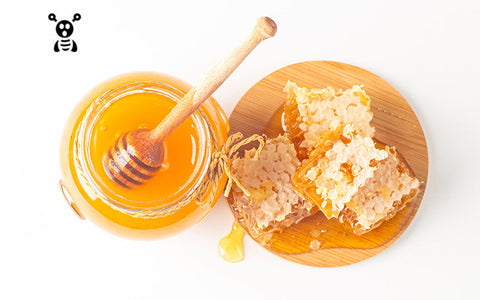Quick Facts about Mad Honey
- Origin: Nepal, Turkey, Georgia
- Botanical Source: Rhododendron ponticum, luteum
- Key Compound: Grayanotoxin
- Effects: Hallucinogenic, anti-inflammatory, aphrodisiac
- Risk Level: High if consumed in excess
Step into the fascinating world of mad honey, a rare and mysterious natural substance derived from the nectar of rhododendron flowers, especially the species luteum and ponticum. Known for their vibrant blooms and rich grayanotoxin content, these plants are the heart of what makes mad honey so uniquely potent.
Harvested in the Himalayan cliffs of Nepal by the legendary Gurung tribe, this Himalayan cliff honey has captivated adventurers, healers, and culinary artists for centuries. In this article, we'll uncover the secrets behind its effects, harvesting traditions, safety, and future potential.
What Makes Mad Honey Unique?
Here’s what makes Mad honey so rare:
-
Source:
Produced from flower nectar, mad honey possesses hallucinogenic and medicinal qualities. Its distinct reddish hue and bitter taste have earned it the nickname "bitter honey."
-
Uses:
Traditionally, the Gurung people have used mad honey to treat ailments like hypertension, diabetes, and general pain relief. It is also believed to have aphrodisiac qualities. -
Harvesting:
Collecting mad honey is among the world’s most dangerous food-gathering traditions. Gurung honey hunters in the Himalayas risk their lives, hanging from ropes on steep cliffs as they face giant bee swarms and unstable terrain. Captured by National Geographic, this process is both a physical challenge and a spiritual ritual.
-
Economic Value:
This harvest supports entire rural communities, offering a sustainable income for villagers who maintain this ancient art.
Mad honey has captivated people for centuries due to its medicinal and hallucinogenic properties. The question "What is mad honey?" continues to intrigue new generations, fueling its demand.
How Mad Honey is Created
Rich in grayanotoxins, a defense mechanism against herbivores, mad honey attracts bees despite its many risks for both pollinators and consumers. Of the many species, this one is among the most notable contributors to mad honey's potency.
According to Functional Ecology, honey bees exposed to grayanotoxins in controlled settings showed higher mortality rates and altered behavior — though these results may differ in wild conditions. Still, only a small number of rhododendron species like ponticum produce nectar potent enough to influence honey toxicity.
Mad Honey: The Bees, the Blooms, and the Natural Toxins
Grayanotoxins, the active compounds in mad honey, are not only potent for humans but also impact honey bees. Recent laboratory studies reveal that honey bees exposed to field-realistic doses of grayanotoxins are up to 20 times more likely to die compared to those consuming untreated nectar. While these findings highlight the potential risks to bee populations, they do not conclusively indicate that honey bees in natural environments face the same mortality rates. Despite this, the intricate relationship between mad honey plants, grayanotoxins and bees underscores the delicate balance of nature that produces this extraordinary honey.
Traditional Uses & Rituals of Mad Honey
The first recorded case of mad honey consumption dates back to Greek philosopher and historian Xenophon, who described how a Greek army accidentally ate the honey, became intoxicated, and had to stop their journey for several days to recover.
Today, mad honey is valued not only for its unique effects but also for its potential medicinal properties. Among the Gurung people, it’s traditionally believed to help with several conditions, including:
- Hypertension – thought to help lower high blood pressure naturally.
- Joint pain – used to soothe inflammation and discomfort.
- Digestive issues – taken in small doses to relieve stomach discomfort and promote gut health.
Studies also suggest that grayanotoxins found in mad honey may help reduce blood pressure and stabilise glucose levels in people with diabetes. However, because toxin levels vary between batches, it’s difficult to determine safe and consistent benefits.
Mad honey also carries deep cultural importance in Nepalese traditions. Tribal shamans use it in spiritual gatherings, believing it enhances connection and awareness through controlled ingestion.
For those curious to try, we recommend starting with a safe mad honey dose and consulting a healthcare professional beforehand.

Mad Honey vs Other Honeys
| Type | Region | Toxicity | Taste | Use |
|---|---|---|---|---|
| Nepalese Mad Honey | Nepal | High (grayanotoxins) | Bitter, deep red | Medicinal, limited culinary |
| Turkish Mad Honey | Turkey | Medium | Sweet-bitter | Medicinal, spiritual |
| Regular Wildflower Honey | Global | Non-toxic | Mild, floral | Culinary only |
Expert Insights
The process of cultivating and harvesting mad honey is as fascinating as the traditional uses and beliefs of the product itself. Local beekeepers, also known as "honey hunters," who are experts in the field, often climb dangerous cliffs to retrieve this prized substance - a testament to its worth and rarity. Culinary experts even recommend using it as an ingredient in various meals, such as drizzling it over yogurt, using it as a glaze for meats, adding it to beverages as a natural sweetener, or baking it in desserts. Nonetheless, researchers caution that mad honey should be consumed in moderation, and it is advisable to seek medical advice before ingestion due to its toxic compounds.
Is Mad Honey Safe? How Much to Take?
While mad honey offers intriguing medicinal potential, overconsumption can lead to nausea, dizziness, or cardiac issues. Research suggests microdosing (1 tsp) is typically safe for most adults. To better understand its chemical makeup and potential effects, consult trusted medical sources.
Future Prospects
As the world's interest in natural and organic products continues to grow, many are asking, "What is mad honey?" This intriguing substance, derived from mad honey mountain flowers, is set to become a prominent player in new health trends and culinary innovations. Chefs from around the globe are experimenting with its unique flavour, incorporating it into both sweet and savoury dishes. Meanwhile, the health sector is exploring new therapeutic uses for the grayanotoxins found in mad honey, particularly for their anti-inflammatory and analgesic effects. Conservationists and researchers are also working together to ensure sustainable harvesting practices and study the environmental impacts of increased demand for this rare honey.
Mad honey from Nepal is a unique product that showcases the beautiful relationship between nature and human tradition. This honey not only connects us with Nepal's rich cultural heritage but also presents exciting opportunities for the future of health and gastronomy. If you are interested in sampling the alluring taste of this rare Himalayan honey, Maddest Mad Honey is here to help. We only sell the most potent premium mad honey directly sourced from the honey hunters of Nepal. Every batch of our products is lab-tested to ensure that it meets the highest standards.
Buy your jar of mad honey now and experience a gastronomic delight unlike any other!
Frequently Asked Questions
What makes mad honey different from regular honey?
Mad honey contains grayanotoxins, which can cause hallucinogenic effects. Regular honey lacks these compounds and is used mainly for sweetness and general wellness.
Is it legal to buy mad honey in the U.S.?
Yes, it is legal to purchase mad honey, but it is not FDA-regulated. Always buy from a trusted source with lab-tested products.
Can mad honey be used in cooking?
Yes — chefs often use it in small doses for flavoring. However, due to its potency, recipes should use it carefully and inform diners.
How long do the effects of mad honey last?
Effects vary, but most users experience changes within 15–30 minutes that last up to 24 hours depending on the dose.




